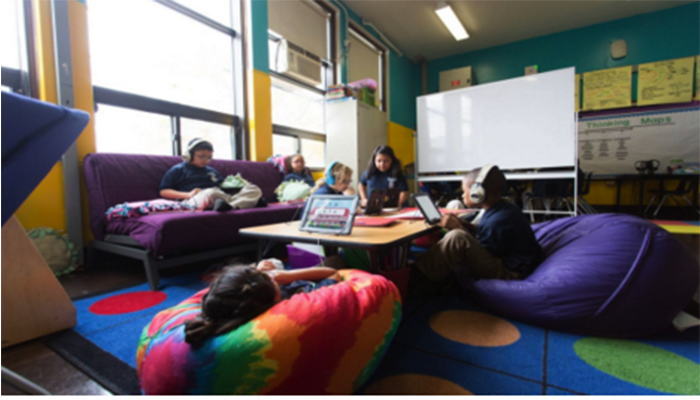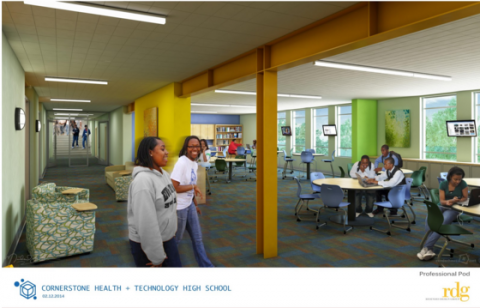Using Space to Realize a Next Gen Learning Vision
Topics

We’ve all had the experience of truly purposeful, authentic learning and know how valuable it is. Educators are taking the best of what we know about learning, student support, effective instruction, and interpersonal skill-building to completely reimagine schools so that students experience that kind of purposeful learning all day, every day.
Practitioner's Guide to Next Gen Learning
Space in next gen schools is designed and used differently to bring a sense of joy, motivation, overall well-being, personalization, and, improve learning.
Have you read the book, The Life-Changing Magic of Tidying Up: The Japanese Art of Decluttering and Organizing? It’s essential message is: surround yourself only with things that inspire joy. It’s revolutionizing how many of us think about our home and office spaces, but what about our learning environments? Do they inspire joy?
Classrooms especially, and schools more generally, are communal spaces. What brings me joy may not bring you joy. Said differently, provided a Goldilocks-style-choice, we might find our best fit in totally different chairs. I’m reflecting on joy here in a deliberately broad and inclusive way—as a gateway to a whole felt sense that I think we want the learning experience to engender. One that promotes overall states of wellbeing as well as specific mindsets and assets.
Let’s use this lens of joy to explore these questions:
How is space in next gen schools designed and used differently, specifically to be more personalized, and why does that matter?
In lieu of a new building or furniture, what actions can we take right away to improve our own and our students' learning?
How might next gen schools continue to invite or allow personalization in the learning environment?
Designing for Learning
It’s helpful to reflect on how we use space and the assumptions behind the design. This begs the question, how do we want learners and learning to be? Next gen learning intends to be constructivist: active, collaborative, creative, inventive, energized, inspired, self-directed, and playful. These words signal a fundamental paradigm shift from the familiar egg carton designs of traditional classrooms and schools where comparatively, learning is sedentary, passive, controlled, solitary and generic. This is why we see next gen schools designing, creating, and using space very differently than traditional schools. We’ll use some pictures from a recent NGLC twitter chat to highlight these examples.
Roughly 30% more space is dedicated to learning.
Hallways and corridors in particular are transformed into impromptu meeting areas with seating for collaborative groups, paired shares, reading nooks, side conversations, and mobile computing. As Trung Le’s article in Fast Company in 2010 suggests “...start by designing corridors that encourage ideas to circulate as freely as foot traffic.” These spaces enable us to interact in different ways. Free-flowing ideas and interactions are at the heart of the idea economy where increasingly new capital is found in networks, relationships, and knowledge. Our learners need interaction skills.

Classroom layouts are flexible.
Furniture can be configured to seat singles, doubles, triads, and larger groups. Castor-footed white boards may be used to section off specific areas for targeted tutoring, blended learning rotations, practice of skills, or group discussions. In a recent EdSurge article, Michael Horn explained,“...since blended-learning schools leverage multiple modes of learning, their spatial needs differ.” He called for “more designs fit for the future.” One important key for achieving better design is gleaned from Intrinsic School’s year-long experience in a temporary space: Ensure students inform the design through constant feedback and iteration.
In flexible learning environments, you’ll see students moving the furniture around to meet their immediate and ever-changing learning needs. Ideal environments allow students to exercise choice in their seating options—tall, short, soft, firm, bouncy, backless, rocking, and with or without arm tables. Having a choice supports the growing identity students have as sovereign individuals and builds awareness of their own emerging preferences (what works for them and why). It’s a precondition and an input to personalizing the learning experience.
#NGLCchat A4: 2/2 as nimble and collaborative as possible and have quite spots. pic.twitter.com/bc3DVv8ftY
— Lisa Palmieri, PhD⚜️ (@Learn21Tech) January 8, 2016
A4: Our space also narrate the language of possibility and our values @BklynLabSchool #NGLCchat pic.twitter.com/in4hP68NkR
— Erin Mote (@erinmote) January 8, 2016
The space is alive and inviting.
This infographic from USC Rossier School highlights key elements of good classroom design including important but obvious elements like use of color. Research indicates that improvements to classroom layout can increase students’ academic engagement up to 45 percent.
Similarly, students exposed to more daylight score 26 percent higher on math and reading. In and outside the classroom, next gen schools use glass walls to encourage flow and transparency. Natural light, plants, and outdoor views are abundant.
Some schools are housed in inspiring, meaningful, or historic settings. e3 Civic High is in a library. MIT is part of a college campus. Brooklyn LAB is co-housed with an entrepreneurial hub. You’ll find next gen schools in museums, art institutes, remodeled train stations, and environmental centers—as these locations leverage student connectedness to learning in life—and operating as change agents both in and outside the classroom or school.
Visible elements of home and community engender autonomy and belonging.
Increasingly common are gardens, kitchens, cafés, and ubiquitous access to mobile learning devices with wifi connections. Students are free to take care of their own needs—go to the bathroom, get a snack, move around, take a break, and seek out or offer peer help as needed without asking permission or causing disruption. With access to computers students may manage their own learning schedules, choose between learning options, and review personal data on performance or progress. These cultural norms support autonomy, self-management, and responsibility while also nurturing belonging and connectedness to communal life.
A:4 Partnership in an Urban City Garden to teach Sustainable Urban Agriculture, Health & Wellness #NGLCchat pic.twitter.com/baKmws3lnV
— Dr.Helen V. Griffith (@Drhvgriff) January 8, 2016
Space is used to activate student creativity and agency.
Next gen learning spaces are dedicated to activities that help foster agency—working individually and collectively—to apply knowledge, create, discover, and invent. Utilizing makerspaces and learning studios, schools can develop and credential students’ real world skills using digital portfolios, competency structures, and badges. These spaces promote movement and working with your hands which brain research tells us is important for learning. They’re also noisy (see Roots Elementary’s solution below), so schools have to be creative about where to locate them when overall space is limited; some choose to use outdoor and off-site community-based options when available.
A4:Control noise with ipad center between quiet spaces (e.g. library) and chatty spaces (e.g. makerspace) #NGLCchat pic.twitter.com/3bcG4teYBQ
— Jon Hanover (@jhanover) January 8, 2016
What Can I Do Right Now?
Recently, as part of LEAP Innovations’ professional learning for Breakthrough Schools: Chicago, the city’s educators explored the power of space and design using the lens of making school environments more democratic and less hierarchical. Did you know that simply putting a frame around a marker board makes it more formal and less accessible, inhibiting its use? This is just one tiny example of how design influences the extent to which people do or don’t interact with learning tools and each other. Local expert, Trung Le of Wonder by Design, author of The Third Teacher, and world-renowned architect and designer, led the session.
Most of these educators are not in a position to invest in a new building like Intrinsic, nor secure cool flexible furnishings like CICS West Belden (both Chicago schools). Rather, they’re bound by district procurement policies which value longevity and durability over utility and relevance. The workshop was intended to help educators look at their daily environments with fresh eyes.
What’s different as a result? Little tweaks, but potentially powerful ones, according to LEAP Innovation’s Tim Carnahan. For example, unused space in hallways and related areas is being claimed and repurposed for breakout and collaborative work.
“It’s a bit chaotic, noisy, and out of the norm to have students in the hall working during regular class times,” Tim confessed with an approving smile. “Students are engaged in choosing new vivid paint colors for walls, halls, and other areas. In addition to color and layout changes, students can now write on windows, tables, and walls with washable markers. We think this new level of accessibility and expression helps foster a choice-based mindset, an inclusive and democratic culture, and better sense of ownership and belonging. Trung Le’s team was amazing at helping us surface the blind spots that we, as seasoned educators, have come to assume and accept as the norm. He helped us consider strategies both big and small. I can’t do him justice, but I can affirm this is important to us. LEAP is committed to finding practical, sustainable, and meaningful solutions for educators working in re-design contexts that have significant constraints.”
The Role of Personalization
In his latest book, Are You Fully Charged? The 3 Keys to Energizing Your Work and Life, Tom Rath says intrinsic motivation is linked to feeling purposeful, productive, and happy. Echoing insights similar to those found in Daniel Pink’s book, Drive: The Surprising Truth About What Motivates Us, Rath cites research showing that intrinsic motivation is more sustainable than any external reward. Over time, external rewards can actually serves to demotivate us.
And, importantly, Rath says, “Intrinsic motivations are not universal: they are individualized.” He gives the example of Google’s move to encourage employees to personalize their personal work spaces and make them feel more like home. He says, “Simply being able to decorate your work space with things like plants, art, or pictures of loved ones could increase productivity by 32 percent.” It’s personal reminders of the things that connect us to our felt sense of caring, and being cared for, that make up the fabric of our intrinsic motivations and our sense of belonging.
So, aside from offering a myriad of choices, and smart use of technology, staffing, and time to differentiate and better meet student learning needs, I wonder: When, where and how do we help students to identify or tap into their own intrinsic motivations? Do we help them create and find joy in their environments and their experiences? Are there places and spaces that we could let them own or brand as their own? What might that look like?
Please show us examples of joyful, personalized, intrinsically-motivating spaces and share your stories with us.
Resources:
- Wonderful Classroom Design Literature Review (Princeton University, 2013), compiled by Lawson Reed Wulsin, Jr.
- Inspiration from Trung Le (TEDx Video)
- Make Space: How to Set the Stage for Creative Collaboration (book)
- What if Students Made a School? by Tom Carroll, president emeritus of the National Commission on Teaching and America’s Future (blog)
RELATED POSTS:




